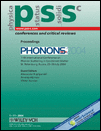Study of the atomic dynamics of nanoclusters Y2SiO5:Pr3+ by the confocal fluorescent microscopy
Abstract
The system under consideration consists of a Pr3+ ion placed into a nanodimensional Y2SiO5 crystal (∼20 nm), which rests on a glass substrate. The spectrum and attenuation of the fluorescence of the Pr3+ ion have been studied by the method of confocal fluorescent microscopy. The rapid electron relaxation in J-multiplets of rare earth impurity ions split by the crystal field (for a usual bulk crystal τ∼10–9–10–12 sec) is shown to be suppressed in the nanodimensional crystal of Y2SiO5:Pr3+. For the excited Stark components of 1D2 multiplet, the electron relaxation appears to be more than 104 times suppressed, while an average splitting of the 1D2 multiplet by the crystal field of ligands is 200 cm–1. The observed phenomena strongly depends on the interaction of the Y2SiO5:Pr3+ cluster with the substrate and the surrounding (‘matrix’). Experimental results and theoretical calculations show the noticeble changes in the structure of vibrational spectrum and the density of vibrational states of the nanodimensional Y2SiO5:Pr3+ crystal. (© 2004 WILEY-VCH Verlag GmbH & Co. KGaA, Weinheim)




